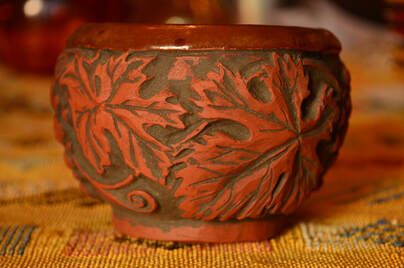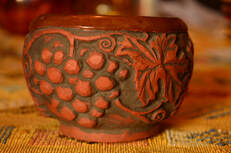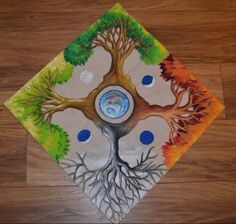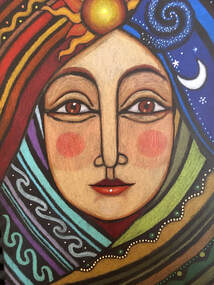Pottery in Late Antique and Medieval Europe

There's not a lot of information in popular historical accounts or art history about pottery as an art form or as something people cared about, but there is a great deal known about pottery styles and types. Ceramic fragments care tested and analyzed to determine when it was made. In places where pottery has been made in the past, pottery is used to date archeological finds. But very often, little attention is given to pottery as an expression of its time or culture.
The one exception is the very fine Greek pottery we see in museums. These wares are beautifully decorated in contrasting colours, and technically, are among the finest pottery ever produced. However, this tradition of pottery-making died out in Greece itself, and had little effect on pottery in the rest of Europe.
The Romans made very fine pottery, and wherever the Roman Empire went, Roman styles and methods of production went as well. Some pottery, like Samian ware produced in southern France, was very finely made, beautiful, and highly prized. The Romans also made many varieties of utilitarian ware for use in the kitchen or at the table. The workmanship was generally good, but the quality of the pots themselves depended on the local clay. Clay is very heavy, so potters work near clay deposits, whether the clay was ideal or not.
Once the Romans left an area, the knowledge of how to make Roman-style pottery or fire Roman-style kilns left with them. In Britain, there had been a long tradition of pottery, which was replaced in most of the British Isles by Roman styles and techniques.
In the Post-Roman era, new forms and styles began slowly to develop. The Anglo-Saxons brought their own types of pottery from the Continent, although the early Saxon potters in what became England were not necessarily as skilled as their counterparts at home. It also took time for kiln technology in Britain to catch up with what was in use on the Continent.
In most of Europe from the invention of pottery into the early Middle Ages, pottery was used for storing and cooking food and beverages, and for food preparation in the kitchen. It was also used for shipping foodstuffs, because it could be made fairly thick, so it wasn't as breakable as glass. It was cheap, so if it only lasted one trip, it was no matter. Archeologists find broken pottery and pottery sherds in medieval towns and settlements all the time, and estimate that most cooking pots lasted only a week or so.
Poor people drank out of wood, bone or antler cups, or leather wineskins, and made bowls or plates out of wood. Wealthier people ate off metal plates and drank out of metal and sometimes glass.
The one thing pottery was used for was jugs, because wine and beer don't taste very good stored in metal. Glass was expensive and very fragile. Pottery jugs also kept the wine slightly cooler due to transpiration, so this was also desirable. We find many jugs and pitchers throughout the Middle Ages. Potters could often produce them in precise sizes to use as measures. The Greeks had made amphorae, large 2 handled jugs for storing and shipping wine, and those continued to be be made in many parts of Europe, especially around the Mediterranean. Amphorae have rounded or pointed bottoms, which let them be stacked sideways to be shipped.
Muslims were forbidden to use metal plates and bowls. In the Middle East, Spain and North Africa, pottery was developed into a fine art, and was highly prized. Byzantine potters, poised between the Christian world of Europe and the Islamic world, were able to see and copy styles and techniques from both traditions.
With the Crusades, Europeans brought home pottery as souvenirs. Some was made by Muslim potters, while some was made by Chinese potters. Chinese porcelain in particular was highly prized. The thin walls and pure white colour of porcelain vessels were much admired. From this time on, the history of European pottery became the story of European potters trying to steal or imitate the styles and secrets of Chinese porcelain or Islamic pottery.
When the Moors were forced out of Spain in the 15th century, many Muslim potters settled in Italy and the Byzantine parts of Europe, adding their talents to pottery forms like maiolica and sgraffito. Many well-known Renaissance painters also made pottery, and beautiful pottery plates and jugs became prestige objects of art for the very wealthy merchants in Italy and Venice.
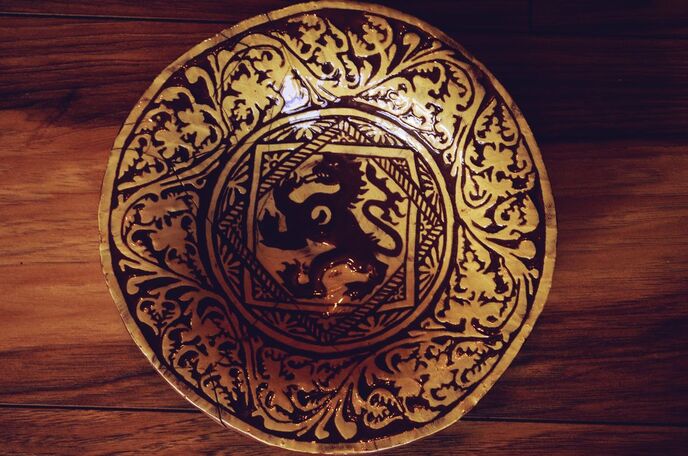
Sgraffito plate, JoAnn Turner. White clay over red clay, fired to Cone 6, fired again with food-safe lead glaze.
The pattern around the rim is taken from several plates made in Italy in the late 15th or early 16th century. The scrolls are identical on these plates, down to the tiniest details, which tells me a stencil or other guide was used to get the same design on items produced in one studio.
The central image is from a Spanish plate of about the same period, with an interlaced 8 pointed star, often seen on Islamic pottery and tilework.
Hand-built round cup, JoAnn Turner.
Made of thick red clay carved into grapes and grapevines, then stained with iron oxide stain to enhance the details. The decorative style is taken from metal objects and sculpture from the late Middle Ages and early Renaissance.
Made of thick red clay carved into grapes and grapevines, then stained with iron oxide stain to enhance the details. The decorative style is taken from metal objects and sculpture from the late Middle Ages and early Renaissance.
